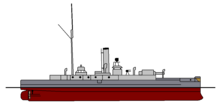SMS Biene

| |
| History | |
|---|---|
| Name | Biene |
| Builder | AG Weser, Bremen |
| General characteristics | |
| Type | Gunboat |
| Displacement | |
| Length | 46.4 m (152 ft) |
| Beam | 10.6 m (34 ft 9 in) |
| Draft | 3.2 to 3.4 m (10 ft 6 in to 11 ft 2 in) |
| Installed power | 800 PS (790 ihp) |
| Propulsion | 2 × double-expansion steam engines |
| Speed | 11 kn (20 km/h; 13 mph) |
| Complement |
|
| Armament | 1 × 30.5 cm (12 in) MRK L/22 gun |
SMS Biene was an ironclad gunboat of the Wespe class built for the German Kaiserliche Marine (Imperial Navy) in the 1870s.
Design
[edit]
The Wespe class of ironclad gunboats arose from the fleet plan conceived by General Albrecht von Stosch, the new Chief of the Kaiserliche Admiralität (Imperial Admiralty), in the early 1870s. He envisioned a fleet oriented on defense of Germany's Baltic and North Sea coasts, which would be led by the ironclad corvettes of the Sachsen class. These were to be supported by larger numbers of small, armored gunboats.[1]
Biene was 46.4 meters (152 ft) long overall, with a beam of 10.6 m (34 ft 9 in) and a draft of 3.2 to 3.4 m (10 to 11 ft). She displaced 1,098 metric tons (1,081 long tons) as designed and 1,163 t (1,145 long tons) at full load. The ship's crew consisted of 3 officers and 73 to 85 enlisted men. She was powered by a pair of double-expansion steam engines that drove a pair of 4-bladed screw propeller, with steam provided by four coal-fired cylindrical boilers, which gave her a top speed of 11 knots (20 km/h; 13 mph) at 800 metric horsepower (790 ihp). At a cruising speed of 7 knots (13 km/h; 8.1 mph), she could steam for 700 nautical miles (1,300 km; 810 mi).[2]
The ship was armed with one 30.5 cm (12 in) MRK L/22 gun in a barbette mount that had a limited arc of traverse. The armored barbette was protected by 203 mm (8 in) of wrought iron, backed with 210 mm (8.3 in) of teak. The ship was fitted with a waterline armor belt that was 102 to 203 mm (4 to 8 in) thick, with the thickest section protecting the propulsion machinery spaces and ammunition magazine. The belt was backed with 210 mm of teak. An armor deck that consisted of two layers of 22 mm (0.87 in) of iron on 28 mm (1.1 in) of teak provided additional protection against enemy fire.[2][3]
Service history
[edit]
The keel for Biene was laid down at the AG Weser shipyard in Bremen in 1876, and she was launched on 2 December 1876. Work on the ship was continued through mid-1877, and she was commissioned into active service on 20 August.[2]
By 1883, the ship had been refitted with an additional 8.7 cm (3.4 in) L/24 built-up guns, a pair of machine guns, and two 35 cm (14 in) torpedo tubes in her bow, both of which were above the waterline.[4]
On 27 September 1910, Biene was struck from the naval register. She was then converted into a floating work shop and used in that capacity for the next decade. She was then sold in Bremen in 1921 and broken up later that year Wewelsfleth.[4]
Notes
[edit]References
[edit]- Gröner, Erich (1990). German Warships: 1815–1945. Vol. I: Major Surface Vessels. Annapolis: Naval Institute Press. ISBN 978-0-87021-790-6.
- Hildebrand, Hans H.; Röhr, Albert & Steinmetz, Hans-Otto (1993). Die Deutschen Kriegsschiffe: Biographien – ein Spiegel der Marinegeschichte von 1815 bis zur Gegenwart [The German Warships: Biographies − A Reflection of Naval History from 1815 to the Present] (in German). Vol. 2. Ratingen: Mundus Verlag. ISBN 978-3-8364-9743-5.
- Lyon, David (1979). "Germany". In Gardiner, Robert; Chesneau, Roger & Kolesnik, Eugene M. (eds.). Conway's All the World's Fighting Ships 1860–1905. Greenwich: Conway Maritime Press. pp. 240–265. ISBN 978-0-85177-133-5.
- Sondhaus, Lawrence (1997). Preparing for Weltpolitik: German Sea Power Before the Tirpitz Era. Annapolis: Naval Institute Press. ISBN 978-1-55750-745-7.
